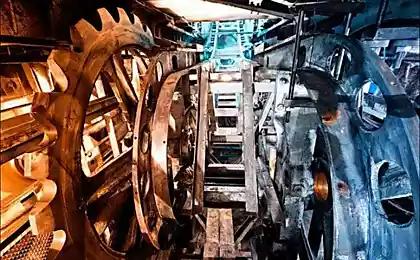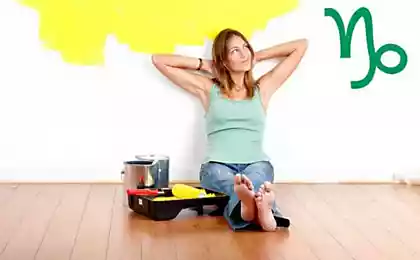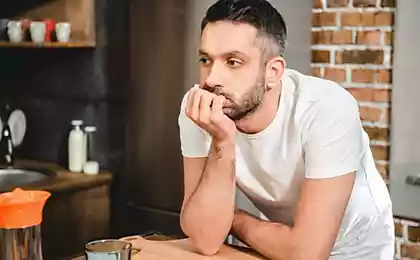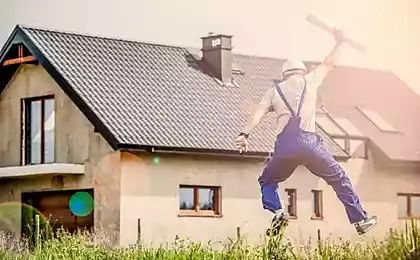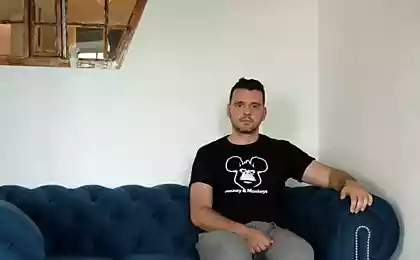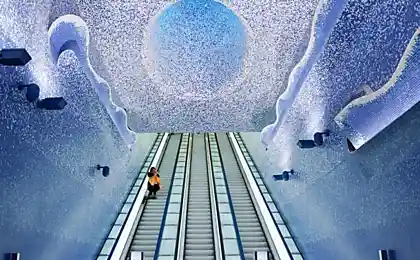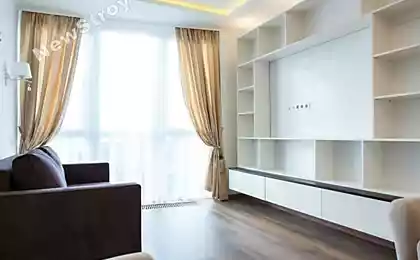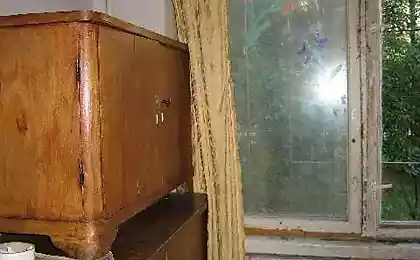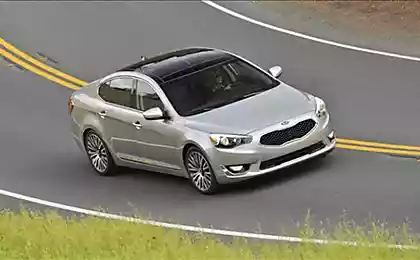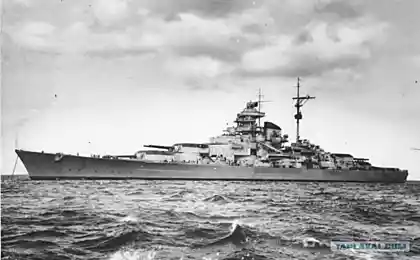1059
Repair escalator
Total 42 photographs
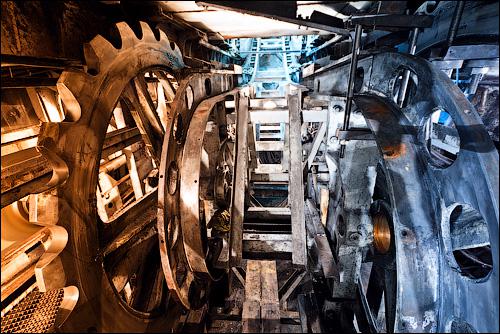
Send this post made me the appearance of this article: see. Link. Rebelled closing station, which is caused by the repair of the escalator, the author immediately repair mixed with politics and sucked from the finger "sensation." Perhaps this was the original intent, and the escalator just an excuse. I do not know. Thus for reasons of limitations of the station at the entrance do not need to go far: they are listed on the official site of the metro. Somehow it seems to me that the sequence of action in clarifying this question should be: first, you call the press service of the subway and know the reasons for the closure of the station, in parallel to investigate the cause, which requires a complete shutdown of the escalator, and why it can not be run at rush hour, and then draw conclusions. Apparently, nothing like this has not been done. Special or not - it does not matter, the result is the same: the nonsense written. On the other hand, it is an indication that the causes of what is happening now, "Polytech" clear not all. Although much on the surface, let's see why repairs escalator - a complex undertaking, and at the same time take a look in the interior escalator economy.
From 9 January, the overhaul of the escalator №3 Art. "Polytechnical Institute". Such repairs are carried out regularly at all the stations, but "Polytech" opened in 1963 and having 3 escalator during repair pops one unpleasant feature. In normal operation of the station in the morning peak flow of people on the way out so that you have to use all three machines: two on the rise and one on the descent. Exactly the same situation in the neighboring "the Station", where the last repair of escalators is just a couple of years ago. So, if one of the escalator stops for repairs, will have to sacrifice something. Leave one escalator to descend on the rise and one can not be one escalator will not be able to remove the entire flow from the bottom and the people will gradually accumulate on the platform. In the worst case it will end someone's falling on the rails. So both of the escalator on the rise will have to leave, and the entrance to the station in the morning peak limit. This measure is unpleasant, but it forced - it is better to create a crowd in an open space, or spend too much time on the road to a nearby subway station, you create the potential flea market underground. It is an unwritten law. It is because of the constant accumulation of people at the station was built by the second transition between "Khreschatik" and "Maidan". For the same reason so desperately need a second transition between the "Theater" and "Golden Gate". Unfortunately, not everywhere and not always fulfill the law, and this is very bad, but wherever possible to avoid the notorious big crowd at the station, the choice can be only one. According to modern construction standards at stations deep foundation with one output should be at least 4 escalator, but the old station with 3 machines something radically change the already very difficult.
Why escalator repair lasts a month or two? Tunnel escalator - quite a complex machine with a large number of moving parts: the same "Polytech" alone steps of nearly 600, and various bearings about 10 thousand. In contrast of floor escalators that we see in various shopping malls, large length of tunnel escalators places specific requirements for durability and reliability of their designs. At the same time, many of the details are subject to considerable wear and tear, if the escalator will operate continuously for a year ladder painting will take place 28 th. Km. Overhaul of escalators, which are set to "Polytechnic Institute" must be performed every 170 thousand. Km. Finally, an escalator - a very important mechanism: for example, by breaking one of the fans the lives of passengers not be under direct threat, as in the case of failure of the escalator consequences can be very unpleasant: the history of fatal crashes were in the post-Soviet space, the recent case with broken handrail on the "Golden Gate", which injured a man - a very easy example of the possible consequences. Therefore, on the condition of all the parts of the escalator it depends very much, and given the amount of one night will not replace all.
During the overhaul of the escalator is almost completely disassembled in a clearly defined sequence: first steps dismantled, and then pulling the chain that pulled the ladder painting, directing, the device responsible for the work of handrails, traction motor, brake, auxiliary drive shafts gear and much more. This remains in place bearing metal escalator and several other parts of the machine, which also pass inspection and repair. On paper, the description of the repair and maintenance of the escalator takes more than a dozen pages.
Recently at the "Polytechnic" ended with the dismantling of the repaired parts of the escalator. Almost all of them are now taken to the escalator service shops that are on the territory of electric depot "Darnitsa". Each item must be disassembled, cleaned of dirt and debris, to examine, if necessary, repair or replace the contents, touch up and reassembled. The problem of the accumulation of debris is very relevant: the soles of shoes people are entered from the street a lot of dirt that still partially inside the escalator. Some components (reagents for ice control) lead to corrosion of the metal. As practice shows, during the overhaul should be changed to 50% coverage of the stairs - it wears out the most.
After an all-out inspection and repair parts of the escalator they are set into place in the reverse order. Thus the completion of all work on the escalator can let passengers only after a complex checks, running and acceptance of regulatory agencies.
1. For the green fence, which appears each time at one of the stations begins repairing the escalator, nothing special there. There is overloaded equipment and perform some repairs to the escalator. The most interesting thing is hidden in the engine room, which is under the passengers' feet.
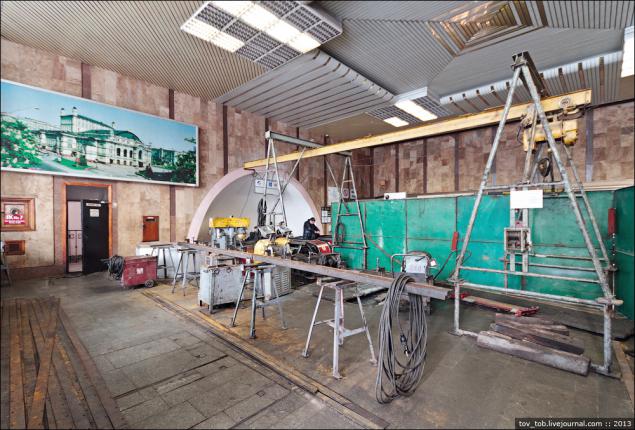
2. polurazobrannom escalator and remove overlap on turbine chamber. Big-eyed readers will be able to see a piece of the top stars, which we will see below.
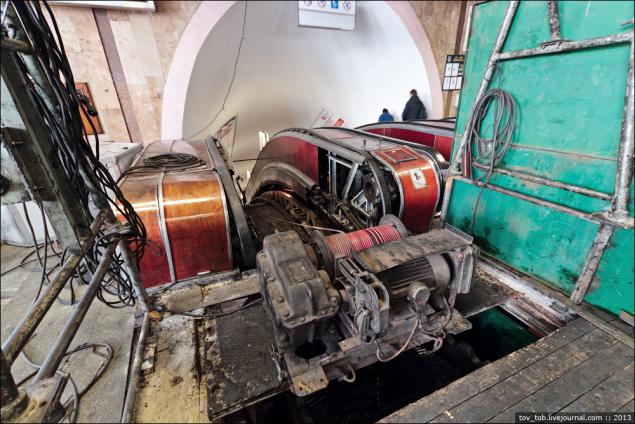
3. down into mash. hall. Type about turnstiles, as if we were looking at the escalator to the level we are used to. Left escalator №2, right - №1. №3 hidden them from the opposite side of mash. hall. Drives of escalators are located at different distances from the input area, as their size does not allow to put all the equipment between neighboring machines. For those interested: the three escalators have type LT-3, height 49, 4 m.

4. 1st car. Right - the engine brake, the left behind bars rotate the upper sprocket, which overturned an endless stream stage.
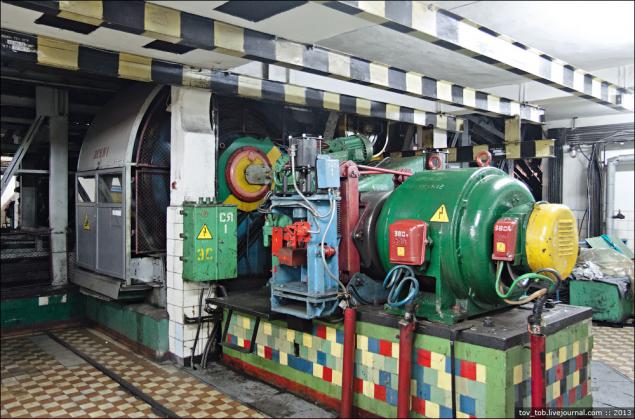
5. On the reverse side appears gear housing, through which the torque from the engine is transmitted to the sprocket.
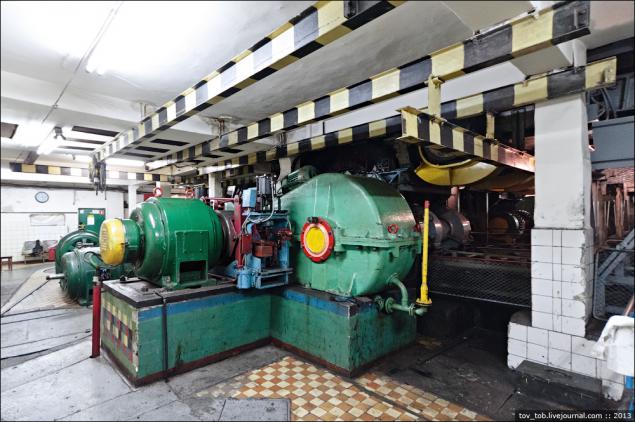
6. You can look inside the main structure of the escalator and watch the movement of the inverted steps:

7. Each escalator is equipped with powerful traction motor, which should provide a start-up of the escalator on the rise with the greatest possible load.
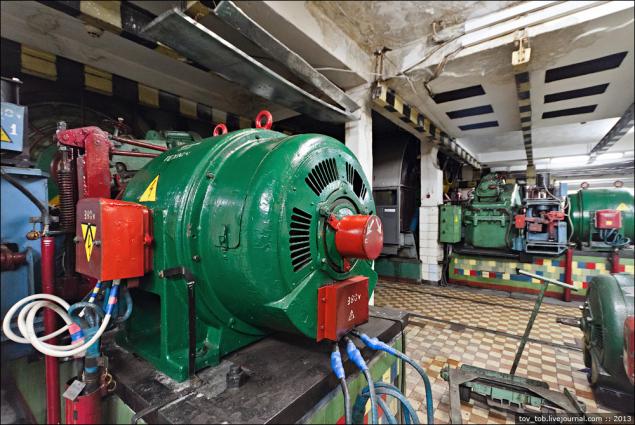
8. On the input shaft of the gearbox is equipped with an automatic brake escalator. The brake must operate when disconnected from the engine torque, which provides at least twice the stock while keeping the workload. As the brake, and the entire escalator, crammed with a bunch of very different sensors. The safety of passengers on the escalator depends primarily on the device and at the slightest suspicion of a fatal error (an increase in the speed of the escalator on the 30% of the set, the spontaneous change of direction of the escalator operating on the rise, and so on) should be an escalator stopped. By the way, note the red emergency stop button at the bottom of the brake.
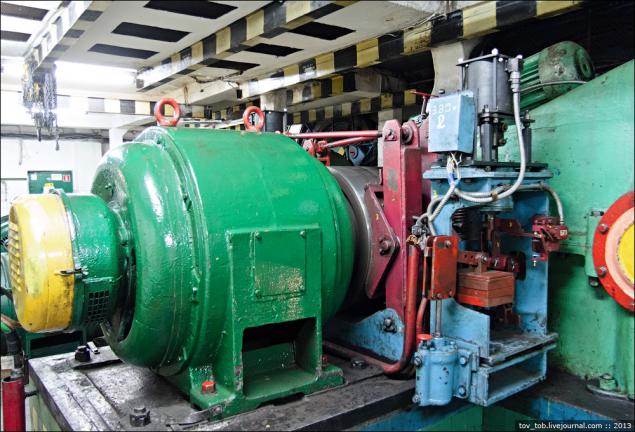
9. The operation of the escalator and the control of its various parameters derived from this cabinet. In recent years, the old electrical equipment at the first station is gradually replaced by modern electronics, but the question of a radical renewal, as always, depends on funding - according to workers escalator service a locker costs about 900 thousand. UAH.

10. And so the computer room for the first stations of the Kiev subway appeared before (this is not "Polytech»):

11. Huge racks releshkami, fuses, batchfile different pokazometrami and other electrical romance.
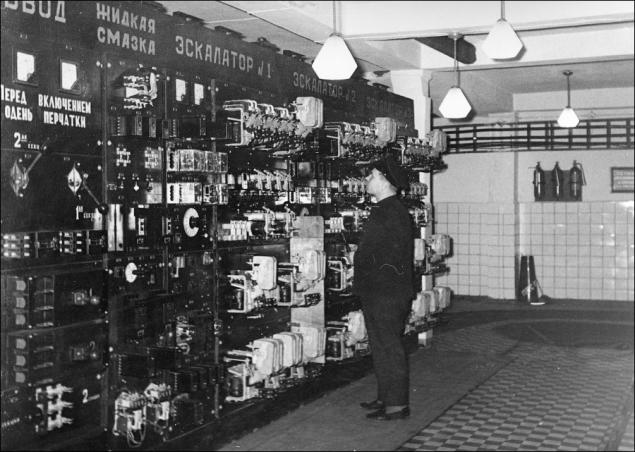
12. In some places, there are still archaisms:
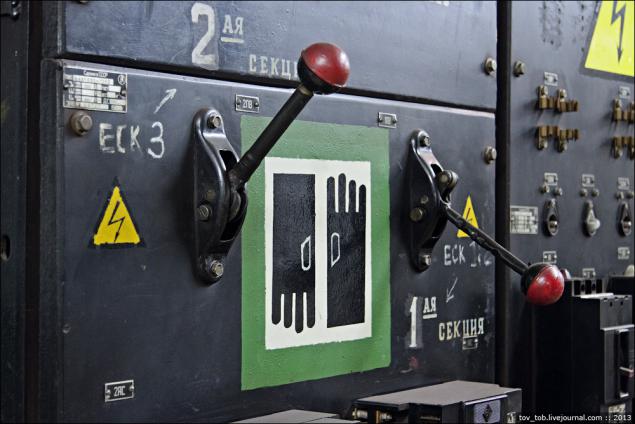
13. Also preserved and rails with turntable, by which a special trolley for mash. Hall moved loads. Newer mash. the halls of a "railway" is no more.
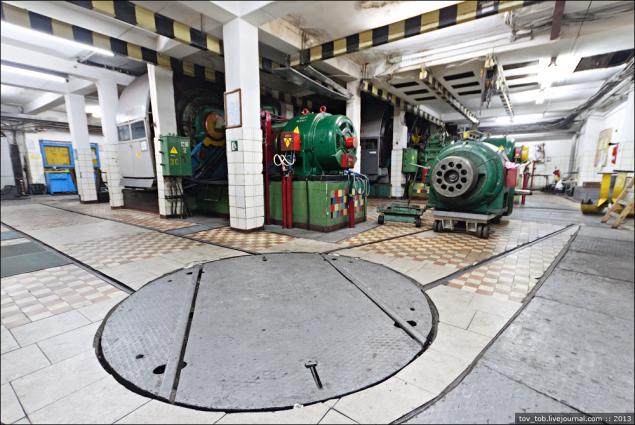
14. Unplanned shutdown and failure of the escalator - PE. The turbine hall always available emergency kits for rapid replacement of defective parts. There's even a backup drive motor:

15

16. But let us finally look at the disassembled machine. From what we have seen in the previous photo here was only gearbox and drum brakes. To the left was the engine in the middle you can see the open star.

17. Close of the left guard.

18. Reducer. Almost all the brake components are dismantled.
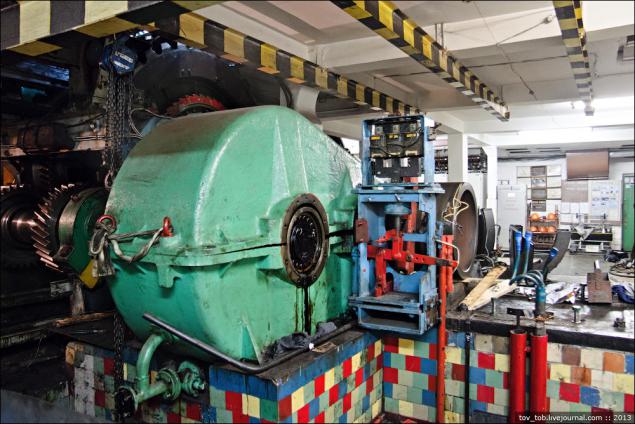
19. The main shaft bearings:

20

21. The upper sprocket. She hung on the chain, which in turn pulls on the steps themselves.
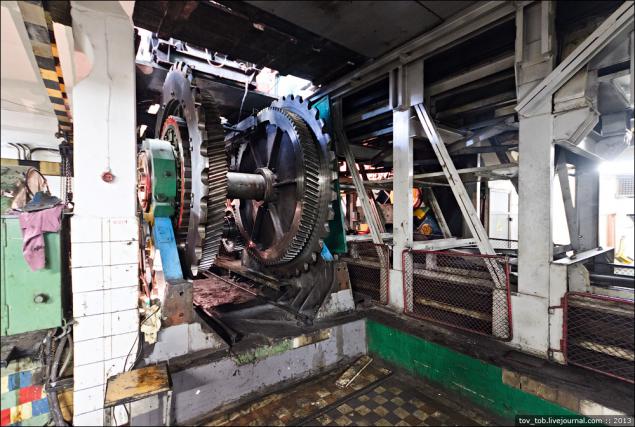
22
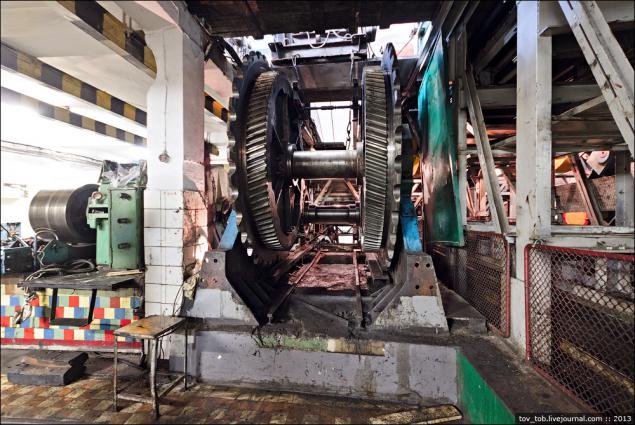
23. The force from the engine is transmitted through the gearbox to the main shaft that rotates and a star:

24. Call the passage under the balustrade to service machines between 3rd and 2nd escalator. Ahead 100 meters tightness angle of 30 °.

25. Inside the structures dismantled escalator. In normal times, the same level as the steps move in the direction opposite the main movement.
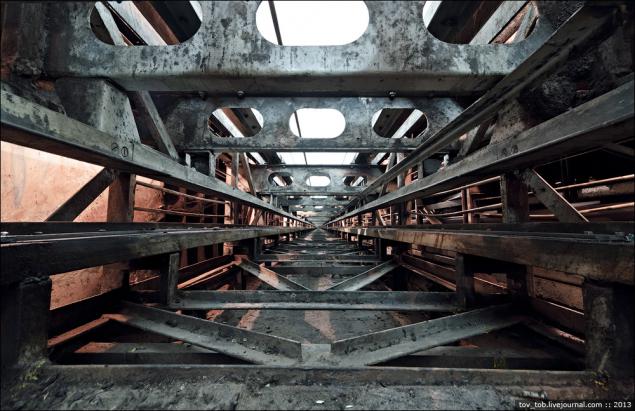
26. At the top of the escalator handrail mounted tensioning system:

27. Given the great length of the escalator tunnel and changing load, without more dynamic stretch fabric ladders and handrails can not do.

28. Tightening ladder web site is under the bottom of the escalator in the so-called tension chamber. There is an asterisk in the lower movable carriage, which is using a system of levers pulled a few goods, which you see on the left.
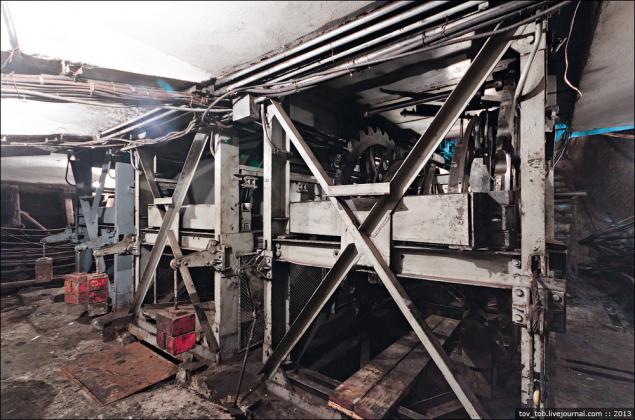
29. Lower asterisk dismantled machines:

30. At the same time let's look at two more stations and see how the look more modern machines. Station "Cave" (opened in 1997), the turbine building of the upper slope. 4 Machine ET-3M type, height 21 m 6. Immediately catches the eye more compact placement of certain sites, for example, the traction motor is hidden under the top star.
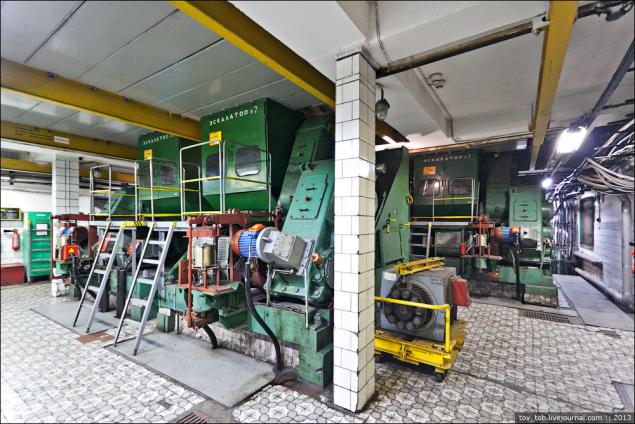
31. The upper sprocket 4th machines and outdoor gear (photos Cap. Repair 2011):

32
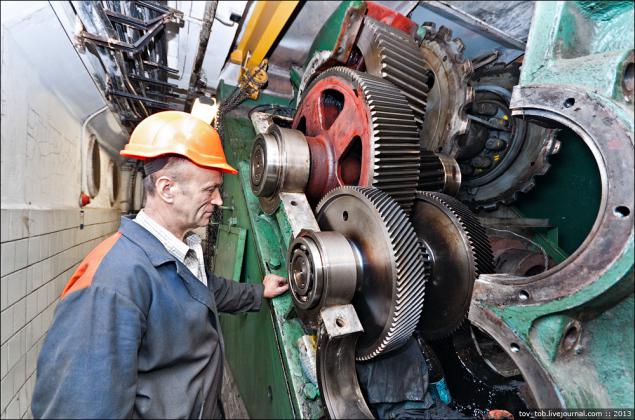
33. The control station escalator is also more compact and looks more modern:
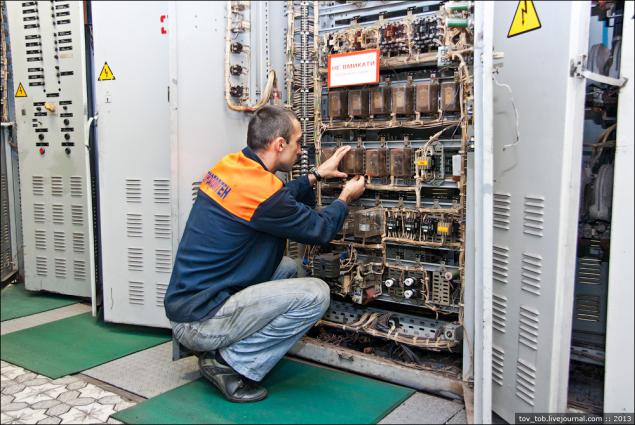
Article 34. Turbine hall. "Syrets" (2004). There are already installed 4 Kryukov machines ETC-245 with a lifting height of 43 m. The whole layout is very reminiscent of "Caves", although modern technology and new solutions have had some influence on the structure.

35. A small motor, painted in blue - is an auxiliary drive, which is used during repair and adjustment work to move the ladder web at no more than 4 cm / s. There he is on the "Cave" and "Polytechnic Institute".
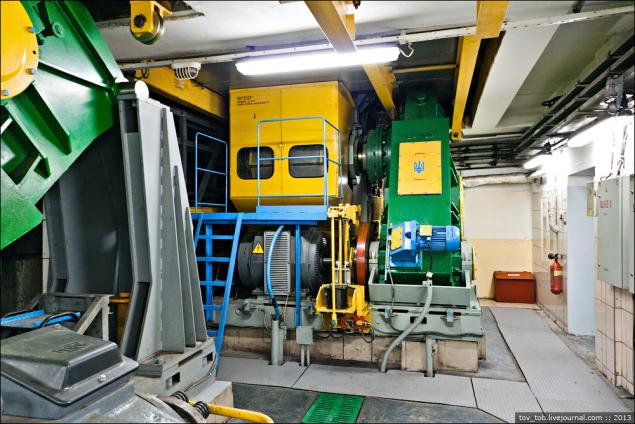
36
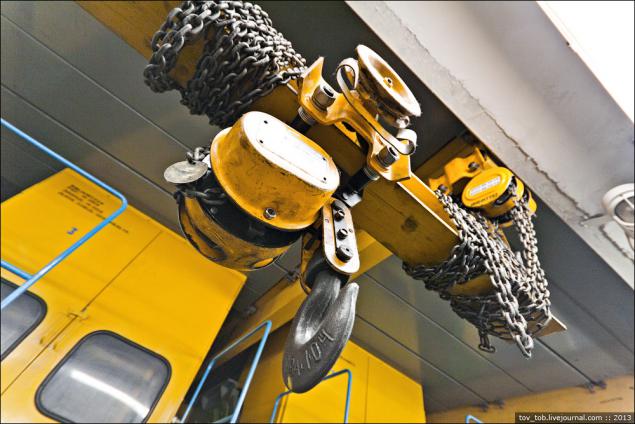
37. Wherever you look, everywhere various sensors that monitor the operation of the escalator:

38
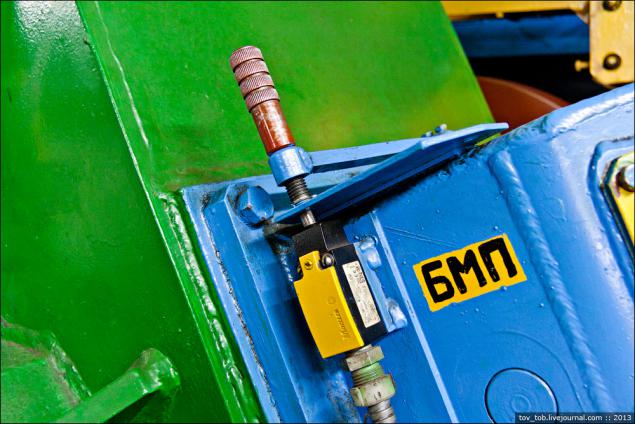
39. "Syrets" control station escalator already has an electronic stuffing.
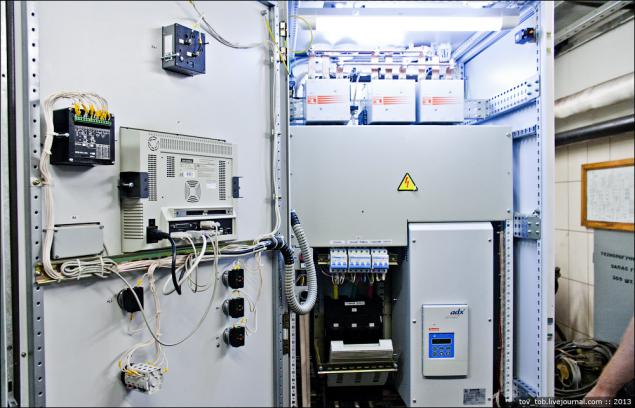
40. According to the list of locks is possible to estimate the number of sensors:

41. "Syrets" as there are freelancers escalator service :)
P.S. The longest escalator in Kiev installed at the station. "Khreshchatyk" (between the station and the exit to the street. Gorodetsky). Lifting height - 65, 8 m., The number of stages - 715/743. The escalator was made on spec. order (for escalators type LT-2 maximum lifting height - 65 m).
Thanks to the press service of the Kiev Metro for organizing the shooting.
source

Source:

Send this post made me the appearance of this article: see. Link. Rebelled closing station, which is caused by the repair of the escalator, the author immediately repair mixed with politics and sucked from the finger "sensation." Perhaps this was the original intent, and the escalator just an excuse. I do not know. Thus for reasons of limitations of the station at the entrance do not need to go far: they are listed on the official site of the metro. Somehow it seems to me that the sequence of action in clarifying this question should be: first, you call the press service of the subway and know the reasons for the closure of the station, in parallel to investigate the cause, which requires a complete shutdown of the escalator, and why it can not be run at rush hour, and then draw conclusions. Apparently, nothing like this has not been done. Special or not - it does not matter, the result is the same: the nonsense written. On the other hand, it is an indication that the causes of what is happening now, "Polytech" clear not all. Although much on the surface, let's see why repairs escalator - a complex undertaking, and at the same time take a look in the interior escalator economy.
From 9 January, the overhaul of the escalator №3 Art. "Polytechnical Institute". Such repairs are carried out regularly at all the stations, but "Polytech" opened in 1963 and having 3 escalator during repair pops one unpleasant feature. In normal operation of the station in the morning peak flow of people on the way out so that you have to use all three machines: two on the rise and one on the descent. Exactly the same situation in the neighboring "the Station", where the last repair of escalators is just a couple of years ago. So, if one of the escalator stops for repairs, will have to sacrifice something. Leave one escalator to descend on the rise and one can not be one escalator will not be able to remove the entire flow from the bottom and the people will gradually accumulate on the platform. In the worst case it will end someone's falling on the rails. So both of the escalator on the rise will have to leave, and the entrance to the station in the morning peak limit. This measure is unpleasant, but it forced - it is better to create a crowd in an open space, or spend too much time on the road to a nearby subway station, you create the potential flea market underground. It is an unwritten law. It is because of the constant accumulation of people at the station was built by the second transition between "Khreschatik" and "Maidan". For the same reason so desperately need a second transition between the "Theater" and "Golden Gate". Unfortunately, not everywhere and not always fulfill the law, and this is very bad, but wherever possible to avoid the notorious big crowd at the station, the choice can be only one. According to modern construction standards at stations deep foundation with one output should be at least 4 escalator, but the old station with 3 machines something radically change the already very difficult.
Why escalator repair lasts a month or two? Tunnel escalator - quite a complex machine with a large number of moving parts: the same "Polytech" alone steps of nearly 600, and various bearings about 10 thousand. In contrast of floor escalators that we see in various shopping malls, large length of tunnel escalators places specific requirements for durability and reliability of their designs. At the same time, many of the details are subject to considerable wear and tear, if the escalator will operate continuously for a year ladder painting will take place 28 th. Km. Overhaul of escalators, which are set to "Polytechnic Institute" must be performed every 170 thousand. Km. Finally, an escalator - a very important mechanism: for example, by breaking one of the fans the lives of passengers not be under direct threat, as in the case of failure of the escalator consequences can be very unpleasant: the history of fatal crashes were in the post-Soviet space, the recent case with broken handrail on the "Golden Gate", which injured a man - a very easy example of the possible consequences. Therefore, on the condition of all the parts of the escalator it depends very much, and given the amount of one night will not replace all.
During the overhaul of the escalator is almost completely disassembled in a clearly defined sequence: first steps dismantled, and then pulling the chain that pulled the ladder painting, directing, the device responsible for the work of handrails, traction motor, brake, auxiliary drive shafts gear and much more. This remains in place bearing metal escalator and several other parts of the machine, which also pass inspection and repair. On paper, the description of the repair and maintenance of the escalator takes more than a dozen pages.
Recently at the "Polytechnic" ended with the dismantling of the repaired parts of the escalator. Almost all of them are now taken to the escalator service shops that are on the territory of electric depot "Darnitsa". Each item must be disassembled, cleaned of dirt and debris, to examine, if necessary, repair or replace the contents, touch up and reassembled. The problem of the accumulation of debris is very relevant: the soles of shoes people are entered from the street a lot of dirt that still partially inside the escalator. Some components (reagents for ice control) lead to corrosion of the metal. As practice shows, during the overhaul should be changed to 50% coverage of the stairs - it wears out the most.
After an all-out inspection and repair parts of the escalator they are set into place in the reverse order. Thus the completion of all work on the escalator can let passengers only after a complex checks, running and acceptance of regulatory agencies.
1. For the green fence, which appears each time at one of the stations begins repairing the escalator, nothing special there. There is overloaded equipment and perform some repairs to the escalator. The most interesting thing is hidden in the engine room, which is under the passengers' feet.

2. polurazobrannom escalator and remove overlap on turbine chamber. Big-eyed readers will be able to see a piece of the top stars, which we will see below.

3. down into mash. hall. Type about turnstiles, as if we were looking at the escalator to the level we are used to. Left escalator №2, right - №1. №3 hidden them from the opposite side of mash. hall. Drives of escalators are located at different distances from the input area, as their size does not allow to put all the equipment between neighboring machines. For those interested: the three escalators have type LT-3, height 49, 4 m.

4. 1st car. Right - the engine brake, the left behind bars rotate the upper sprocket, which overturned an endless stream stage.

5. On the reverse side appears gear housing, through which the torque from the engine is transmitted to the sprocket.

6. You can look inside the main structure of the escalator and watch the movement of the inverted steps:

7. Each escalator is equipped with powerful traction motor, which should provide a start-up of the escalator on the rise with the greatest possible load.

8. On the input shaft of the gearbox is equipped with an automatic brake escalator. The brake must operate when disconnected from the engine torque, which provides at least twice the stock while keeping the workload. As the brake, and the entire escalator, crammed with a bunch of very different sensors. The safety of passengers on the escalator depends primarily on the device and at the slightest suspicion of a fatal error (an increase in the speed of the escalator on the 30% of the set, the spontaneous change of direction of the escalator operating on the rise, and so on) should be an escalator stopped. By the way, note the red emergency stop button at the bottom of the brake.

9. The operation of the escalator and the control of its various parameters derived from this cabinet. In recent years, the old electrical equipment at the first station is gradually replaced by modern electronics, but the question of a radical renewal, as always, depends on funding - according to workers escalator service a locker costs about 900 thousand. UAH.

10. And so the computer room for the first stations of the Kiev subway appeared before (this is not "Polytech»):

11. Huge racks releshkami, fuses, batchfile different pokazometrami and other electrical romance.

12. In some places, there are still archaisms:

13. Also preserved and rails with turntable, by which a special trolley for mash. Hall moved loads. Newer mash. the halls of a "railway" is no more.

14. Unplanned shutdown and failure of the escalator - PE. The turbine hall always available emergency kits for rapid replacement of defective parts. There's even a backup drive motor:

15

16. But let us finally look at the disassembled machine. From what we have seen in the previous photo here was only gearbox and drum brakes. To the left was the engine in the middle you can see the open star.

17. Close of the left guard.

18. Reducer. Almost all the brake components are dismantled.

19. The main shaft bearings:

20

21. The upper sprocket. She hung on the chain, which in turn pulls on the steps themselves.

22

23. The force from the engine is transmitted through the gearbox to the main shaft that rotates and a star:

24. Call the passage under the balustrade to service machines between 3rd and 2nd escalator. Ahead 100 meters tightness angle of 30 °.

25. Inside the structures dismantled escalator. In normal times, the same level as the steps move in the direction opposite the main movement.

26. At the top of the escalator handrail mounted tensioning system:

27. Given the great length of the escalator tunnel and changing load, without more dynamic stretch fabric ladders and handrails can not do.

28. Tightening ladder web site is under the bottom of the escalator in the so-called tension chamber. There is an asterisk in the lower movable carriage, which is using a system of levers pulled a few goods, which you see on the left.

29. Lower asterisk dismantled machines:

30. At the same time let's look at two more stations and see how the look more modern machines. Station "Cave" (opened in 1997), the turbine building of the upper slope. 4 Machine ET-3M type, height 21 m 6. Immediately catches the eye more compact placement of certain sites, for example, the traction motor is hidden under the top star.

31. The upper sprocket 4th machines and outdoor gear (photos Cap. Repair 2011):

32

33. The control station escalator is also more compact and looks more modern:

Article 34. Turbine hall. "Syrets" (2004). There are already installed 4 Kryukov machines ETC-245 with a lifting height of 43 m. The whole layout is very reminiscent of "Caves", although modern technology and new solutions have had some influence on the structure.

35. A small motor, painted in blue - is an auxiliary drive, which is used during repair and adjustment work to move the ladder web at no more than 4 cm / s. There he is on the "Cave" and "Polytechnic Institute".

36

37. Wherever you look, everywhere various sensors that monitor the operation of the escalator:

38

39. "Syrets" control station escalator already has an electronic stuffing.

40. According to the list of locks is possible to estimate the number of sensors:

41. "Syrets" as there are freelancers escalator service :)
P.S. The longest escalator in Kiev installed at the station. "Khreshchatyk" (between the station and the exit to the street. Gorodetsky). Lifting height - 65, 8 m., The number of stages - 715/743. The escalator was made on spec. order (for escalators type LT-2 maximum lifting height - 65 m).
Thanks to the press service of the Kiev Metro for organizing the shooting.
source

Source:
